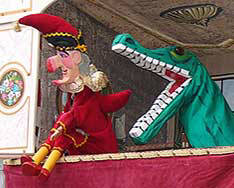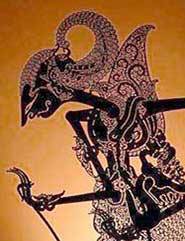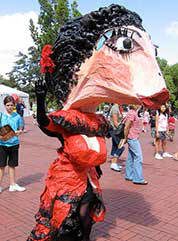
History
Others
Puppets

What is a Puppet?
A Costume Puppet at a Carnival (Left)
Punch & Judy (Above)
Wayang Kulit Shadow Puppet (Right)



Puppets are deeply embedded into British society. On the most basic level, the child that makes his teddy walk and talk for the pleasure of his parents is putting on a primitive puppet show. Moving more upmarket, there's the traditional Punch and Judy performances that are sometimes seen during holidays to the seaside, as well as at a number of puppet theatres dotted around Britain. Then there's television. Children's schedules are positively flourishing with them. Children tend to gain great pleasure from seeing large furry likenesses, that may strike a passing resemblance to their own pets or toys, talking and acting as if they were human. Due to this appeal to the little ones it is hardly surprising that the television executives often write off the puppet as kiddie's stuff, but is this the right attitude? Are they just entertainment for infants, or is there a wider appeal?
Before we can begin to answer these questions, first of all we need to determine what a puppet actually is. The Encyclopedia Britannica has a definition. 'A puppet is an inanimate object moved by human agency in some kind of theatrical show.' This explanation is loose enough to encompass a substantial amount of different puppet types. However, puppets used in the medium of the small screen generally fall into three main areas - marionettes, hand or glove puppets and rod puppets.
Marionettes are complete figures with articulated limbs, and are controlled from above with strings. Many of the early puppets on British television were marionettes, but it was the shows such as Gerry Anderson's Thunderbirds that brought a technological whizz to this historic form of puppetry. Hand or glove puppets, such as children's favourite Sooty, are simpler, often comprising of a hollow strip of material, inside of which is the puppeteer's hand. Controlling from below, the fingers fit inside the head and arms to give the appearance of life. Rod puppets are again controlled from below, but this time rods are used to move the limbs. Most modern television puppets are a combination of the hand and rod puppet, including the likes of Jim Henson's Muppet Show and Fluck and Law's Spitting Image. These definitions rule out stop motion classics such as The Clangers and Bagpuss.
People dressed in costume, such as Big Bird in Sesame Street, can also be described as puppets. The practice of hiding the actor's features with an external frame blurs the division between acting and puppetry. In the past many puppet theatres tried to obtain lifelike human responses from their puppets. In today's modern society we can often see human actors attempting, and indeed succeeding, to become less human and more like the puppet. In the end, both the puppet and actor meet in the middle with the same effect. Neither fully human, but neither fully inanimate and lifeless.
Often, puppets are enhanced using an advanced area of puppetry called animatronics. Animatronics combines the use of electronics and mechanics to create a more realistic illusion of life, often using the likes of cables, compressed air and remote controls. The technique can be traced back to early clock makers, when they created animated figures to move at specific times of the day. The cuckoo clock is prime example of the early days of animatronics, but could not be deemed to be a puppet. The modern era of animatronics began with Walt Disney in the 1960s, where moving figures were built for his theme parks, and later he used an animatronics bird in the film Mary Poppins. Today, the technique is applied to many types of puppets to give them more realistic reactions. Moving eyes and other expressions and movements can be performed, often controlled remotely by another puppeteer.
As you can see, puppetry has evolved greatly over the years. It is an ancient art form. Puppet shows appear throughout history, in almost all time periods and civilisations. Indeed they were mentioned as early as 500BC in such written works as The Symposium by Xenophon, the Greek historian. The Wayang Kulit shadow puppets of Central Java are still used today, and are one of the oldest methods of traditional storytelling in the world. In the 17th century, the Bunraku puppets of Japan regularly replaced live actors on stage. Legends say that one famous playwright tired of the ego of his actors, and decided that his plays were better off being performed by wooden puppets. In Europe they too thrived, often being used in morality plays. The puppet could take on a persona and perform acts that a human would never have got away with. It is highly likely that the puppet theatre predated written drama, and perhaps even the development of writing itself. The origins of puppets can be traced back to religious ceremonies and black magic. This can be further demonstrated by an Elizabethan word for puppet - 'mammet'. Its meaning is not only 'puppet' but also 'idol'. Ancient cultures often used moving figurines to worship their gods, for example the Laps in the 17th century incorporated a puppet of Thor into their religious festivals. It was against the power of these puppet idols that the Second Commandment was aimed. Ironically, monks and priests later used puppets to spread the word of Christianity by performing Bible stories to the masses. Through time, the magical reasoning and beliefs behind the puppet have been forgotten and replaced with the more traditional performances we see today.
By the 19th century, puppets were becoming divorced from theatre in Britain, and the puppeteers themselves took position more as buskers performing at fairs and seaside resorts. Gradually, they began to be seen as lowbrow entertainment. When cinema arrived, it hastened the decline of the traditional puppet theatre. Then in post-war Britain, the BBC began a regular television service to the population. It was very different service to that which we know today. Male presenters were expected to wear black-tie-dress and women wore evening gowns. Programmes were transmitted live and in glorious black and white. Class distinction and the Home Counties accent ruled the day, and in 1947 only 34,000 television sets were in use.
Many traditional puppeteers greeted this new technology with excitement, believing it to be the ideal medium to bring their art to new audiences. However, simply transferring the puppet theatres' performances onto the television screen proved to be ineffective. Traditional puppet shows were not designed to be shown in this manner, and as they stood could not be easily made in a format for the viewers to enjoy. Often variety shows were the only place for a puppet performance. A new track was needed.


This website is the copyright of Benjamin Burford-Jones 2014, except quotations and photographs used to illustrate various traditional and television puppets.
No material should be reproduced in any form whatsoever for purposes of commercial gain without obtaining the copyright holder’s express permission.
Herb the Owl | Alex the Droog | What is a Puppet | Watching With Mother | Gerry Anderson | Jim Hensons Muppets
From Satire to Sitcom | Are Puppets Just for Kids | About the Author and Links















